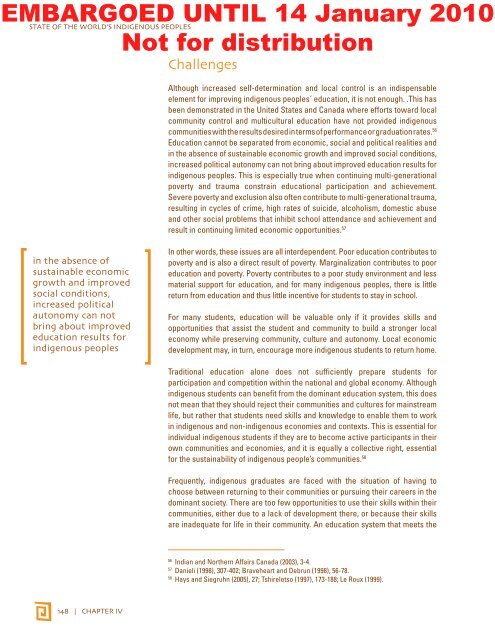STATE OF THE WORLD's INDIGENOUs PEOpLEs - CINU
STATE OF THE WORLD's INDIGENOUs PEOpLEs - CINU
STATE OF THE WORLD's INDIGENOUs PEOpLEs - CINU
- No tags were found...
Create successful ePaper yourself
Turn your PDF publications into a flip-book with our unique Google optimized e-Paper software.
EMBARGOED UNTIL 14 January 2010<strong>STATE</strong> <strong>OF</strong> <strong>THE</strong> WORLD’S INDIGENOUS PEOPLESNot for distributionChallengesAlthough increased self-determination and local control is an indispensableelement for improving indigenous peoples´ education, it is not enough. .This hasbeen demonstrated in the United States and Canada where efforts toward localcommunity control and multicultural education have not provided indigenouscommunities with the results desired in terms of performance or graduation rates. 56Education cannot be separated from economic, social and political realities andin the absence of sustainable economic growth and improved social conditions,increased political autonomy can not bring about improved education results forindigenous peoples. This is especially true when continuing multi-generationalpoverty and trauma constrain educational participation and achievement.Severe poverty and exclusion also often contribute to multi-generational trauma,resulting in cycles of crime, high rates of suicide, alcoholism, domestic abuseand other social problems that inhibit school attendance and achievement andresult in continuing limited economic opportunities. 57in the absence ofsustainable economicgrowth and improvedsocial conditions,increased politicalautonomy can notbring about improvededucation results forindigenous peoplesIn other words, these issues are all interdependent. Poor education contributes topoverty and is also a direct result of poverty. Marginalization contributes to pooreducation and poverty. Poverty contributes to a poor study environment and lessmaterial support for education, and for many indigenous peoples, there is littlereturn from education and thus little incentive for students to stay in school.For many students, education will be valuable only if it provides skills andopportunities that assist the student and community to build a stronger localeconomy while preserving community, culture and autonomy. Local economicdevelopment may, in turn, encourage more indigenous students to return home.Traditional education alone does not sufficiently prepare students forparticipation and competition within the national and global economy. Althoughindigenous students can benefit from the dominant education system, this doesnot mean that they should reject their communities and cultures for mainstreamlife, but rather that students need skills and knowledge to enable them to workin indigenous and non-indigenous economies and contexts. This is essential forindividual indigenous students if they are to become active participants in theirown communities and economies, and it is equally a collective right, essentialfor the sustainability of indigenous people’s communities. 58Frequently, indigenous graduates are faced with the situation of having tochoose between returning to their communities or pursuing their careers in thedominant society. There are too few opportunities to use their skills within theircommunities, either due to a lack of development there, or because their skillsare inadequate for life in their community. An education system that meets the56Indian and Northern Affairs Canada (2003), 3-4.57Danieli (1998), 307-402; Braveheart and Debrun (1998), 56-78.58Hays and Siegruhn (2005), 27; Tshireletso (1997), 173-188; Le Roux (1999).148 | CHAPTER IV
















